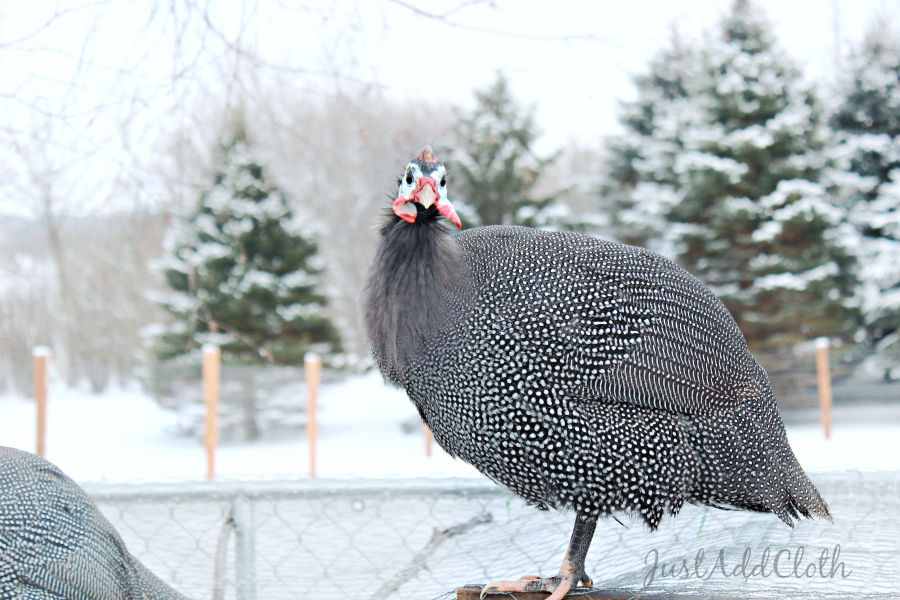 If you think 20 degrees Fahrenheit is cold, you have not experienced winter. There. I said it.
If you think 20 degrees Fahrenheit is cold, you have not experienced winter. There. I said it.
Whenever I see advice for wintering chickens, it is always so incredibly……… quaint. Why? Because to most people, winter is, at worst, 20°F for a couple of months, so they basically can raise their fowl with no changes at all. Meanwhile, we can have windchill of -100, as in 100 degrees below zero, nonstop wind, and an inability to go outside without the snot in your nose freezing solid.
Those cute little warming platforms for water or laying boxes don’t do squat in our winters, and you don’t need them any way.
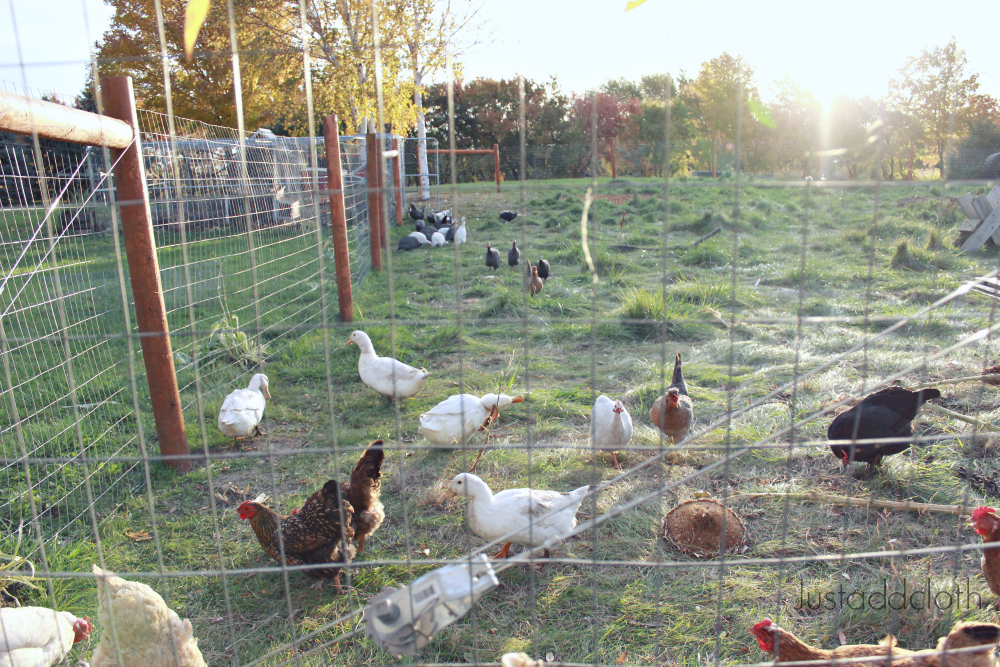 Fowl Paradise
Fowl Paradise
For a lovely time in summer, our birds enjoy 10,000 square feet of fenced in bliss. They frolic through grass, flowers, and thistle, roost in trees, drink from our above ground pond, and enjoy the corn and sunflowers we planted just for them. And then we have Autumn for exactly three days before the snow reaches our waist and the wind makes you want to die. OK, we don’t get quite that despondent. Us true northerners have acclimated to our climate like most animals, and have a tendency to wear nothing but a t-shirt outside when it is above zero degrees F. Your birds will be much the same.

Winterizing Our Chickens In Our Subzero Climate
The Coop
-Don’t heat, acclimate
If you heat a coop, the chickens won’t acclimate to the cold well. Then, when something happens to the heater or the power goes out, those poor birds are gonners. Instead, don’t use any heat. Let their bodies get used to temps as they drop naturally. Everyone I know who lost their chickens in our harsh winters, lost them all when a heater went out. And those same people stopped using heaters and haven’t lost an animal since. Artificial heat makes the animal weak and unable to adjust.
-Deep litter
You mostly want deep litter (leaves, dried grass, pine shavings) in a winterized coop so that you don’t have to scrape poop as often. When it is -40° with a -87° wind chill, no one wants to scrape poop. Also the litter offers more debris for the droppings to land in. Otherwise you just have frozen droppings stuck to the floor. The litter also composts which creates a bit of natural heat, but this should not be your goal.
-More venting is better than less
Moisture in the chicken coop is what causes frostbite on waddles and combs. This moisture can come from too much poop, and too much chicken breath in the air. It will also come from humidity from melt. Temp fluctuations causing melt, increase frostbite. My birds only get frostbite when the weather has big temp changes. So, the swings in weather in the Fall and Spring can hurt my birds, but they are just fine when it is consistently below zero degrees Fahrenheit.
-Block the Wind
Our coop has a screened patio as the first floor, so we use corrugated plastic and ratchet straps to cover the screen when the weather turns cold. If you desire to use this method on certain windows and screens, try to find the clear plastic so the birds still have natural light.
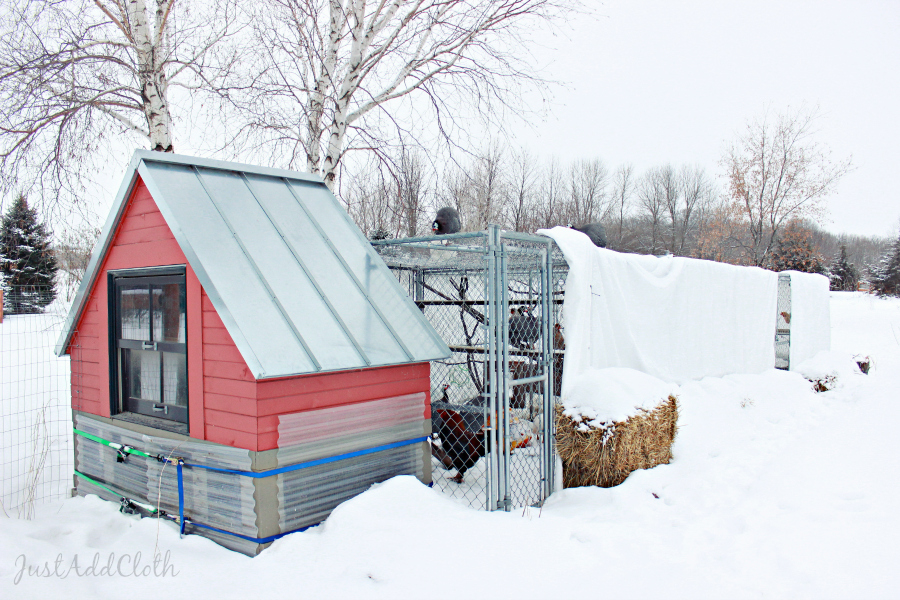
The Chicken Run
-Wind block with vegetation and sturdy tarps
I once read about someone recommending shower curtains as a wind block on the run in winter. I was dubious. I purchased a bunch of higher end curtains only to have them be shredded within an hour. Obviously the person I got this idea from did not live on the plains, AKA the land of no wind breaks. An average day is a constant 40 mph wind. And in winter it gusts to 120 mph. Our public schools are canceled a lot. Haha.
So I recommend the sturdiest tarps you can afford. Make sure they are white so that your run is as bright as possible. Our winter is about six months long and we don’t want the animals shrouded in darkness that whole time. Don’t bother with plastic sheeting, it just tears up immediately unless your run is in the woods or a barn. You want all-weather tarps with a continuous weave and metal grommets.
–Only do a roof if it can support a few thousand pounds
People really underestimate the weight of snow. Considering how many house and garage roofs cave in from too much snow, killing entire families inside, I’m not about to try to put a roof on a chicken run. We just have hardware cloth wired over the top for predators. The snow still accumulates on the chicken wire and hardware cloth causing it to sag, so we do have to go out and shake it off every few hours during storms.
–Add hay bales to the base as extra wind blocking
Line the outside of the run with the bales laying over the tarp bottoms. And then when the spring melt begins you can use that hay for all the mud. Even better, line the inside of the run with bales as well. Although, this can get expensive if your don’t grow your own hay.
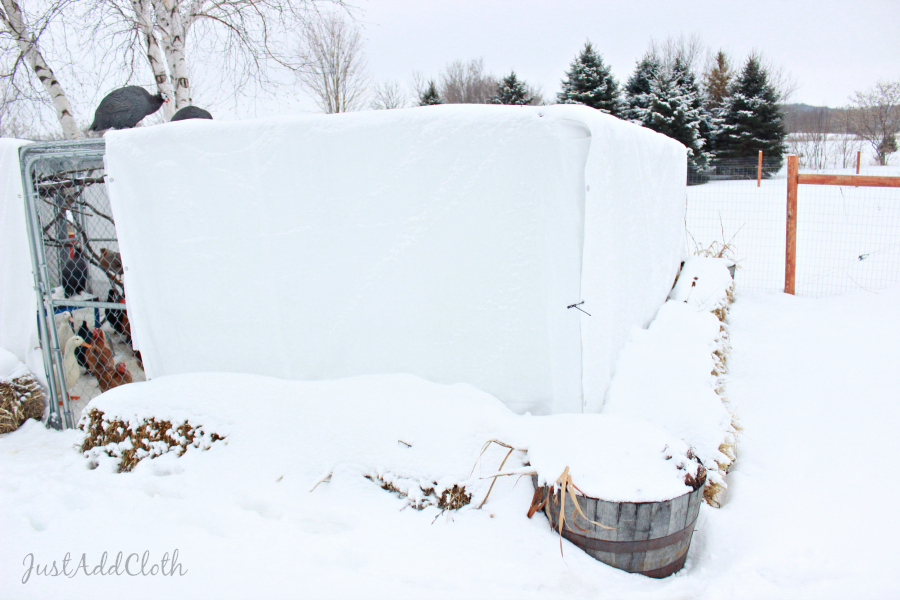 The hay bales make the edges and corners on the western windy side nice and cozy.
The hay bales make the edges and corners on the western windy side nice and cozy.
Food
-Keep it sheltered from snow
I keep it in the “food and socializing coop”. Our birds sleep in one coop and then eat and hangout in another. It forces them out and gives them more activity and stimulus in the boring winter months.
Water
-Don’t bother with warmers
If you have real winter, they don’t work below zero degrees.
Instead we use a rubber tub and fill it half way with hot water. Then add a gallon of hot water periodically through the day to loosen and melt the ice. Dump out the ice block every other day.
Having a couple ducks can help since they are more aggressive with pecking through the ice. The round, black rubber tub shown below is from Tractor Supply Co. Get the big one. It takes longer to freeze up. Don’t use plastic, it just cracks right away when the water freezes and expands.
Eggs
Unfortunately, there isn’t much you can do about eggs freezing and bursting other than to run out to the coop every 45 minutes all day. During the worst of the cold months, we don’t get a ton of eggs. Technically, you could run electric and have a seed germination mat in each laying box to add some warmth, but in a truly cold winter those will work as well as a water warmer.
I know the water and eggs sound like a lot of work, but that is the reality of keeping animals in a climate that most people only witness on television.
The Birds
–Get LARGE Cold hardy chickens
I don’t know anyone who can keep those cute fluffy polish chickens alive in winter here. I know the bantams are cute, but I would only get them if I kept my coop in a large barn so the birds could have the choice to stay inside all day. I have managed to keep guinea fowl alive in winter, but they are pretty fluffy if you allow them to acclimate. They grow extra down better than some fowl.
–Fatten them up
Chicken obesity may be an issue in nicer climates. Here it is a necessity. We get our birds a bit chunky in autumn to help get them through the -47° days in winter. They don’t want to leave the coop for food on the really cold days. Letting them Get a bit fat in Fall helps them stay warmer and hold over better when they go hungry on subzero days.
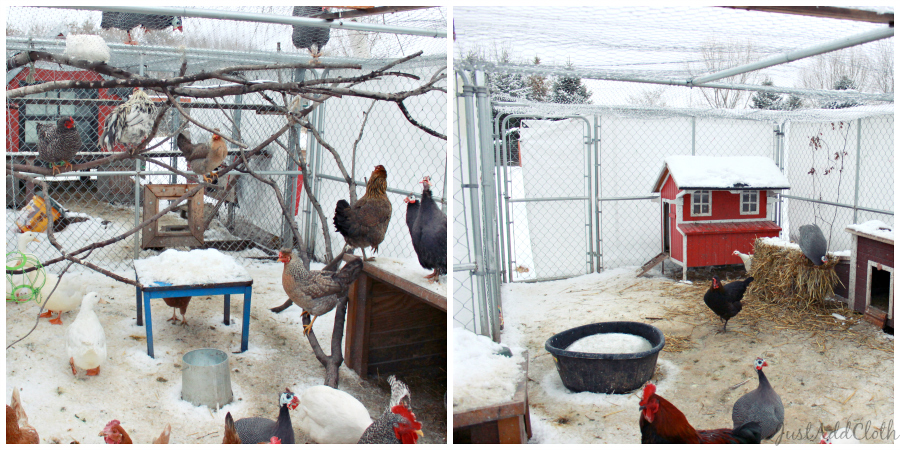
Make their space boredom-proof
Winter is a time of cabin fever for people and animals alike up here. Boredom is bad for the birds, as they will get ornery and begin picking on each other. Our protected run is 500 square feet. In my opinion, this is not really big enough for staying sequestered. We do open the door to free range on most days, but in winter they choose to not wander out in the snow. Since they choose to not get out, we make sure they have stimulus inside the run.
- I put up branches all over for roosting above the ducks. The branch matrix gives then chickens and guineas a place to socialize where ducks won’t bother them.
- We have have hay bales for them to pick apart. All of our animals love to trash a hay bale. And they naturally spread it around for us.
- We have bird pavilions and extra coops for socializing and laying. None of our birds lay eggs in the sleeping coop. They lay in the food coop, the socializing coop, or the rooster coop. (Yes, I find it odd that the roosters decided to make a single coop into their man-cave and not let anyone else in.)
- They have ramps and doors to access another section of run. The doors are too high for the ducks to access.
- We keep all the fowl together. The chickens tend to not squabble with each other when they have ducks and guineas constantly interrupting their shenanigans.
OR, you can avoid a whole bunch of this work by building a big barn and putting your coop in it! Although, that won’t solve most of the cold issues. Honestly, the tarps, hay bales, and snow itself do a pretty good job of making it comfortable in the run. When I step through the gate into the run, I am instantly relieved from the harsh, frigid wind. Our ducks choose to not even sleep in a coop. Not even when temps are dangerously in the negatives. They just snuggle together in a corner of the run. We have not lost a bird to cold yet and as long as we let nature keep them acclimated, I doubt we will. Always remember, extra comfort does not always mean survival. Sometimes it poses more risks than rewards.


Pingback: A Quick Guide to Raising Ducks • Lake and River Studio